SKIPJACK & ALBACORE
THE SMALL TUNAS
By Sam Mossman
I reckon that the most important fish in the ocean is the one on the end of your line, and I have pretty much made a cottage industry out of promoting a sportfishing approach to catching the smaller fish species.
Two of the most dynamic and exciting species to catch in the light tackle arena are skipjack and albacore. There are other small tuna species in New Zealand waters, such as slender tuna and bullet tuna, but these are uncommon. Albacore and skipjack are extremely fast, stubborn yet clean fighters and a lot easier to come by than larger gamefish like marlin, yellowfin or bluefin. Scale down your gear to the proportions of these smaller fish and you have gamefishing in microcosm, just as exciting and challenging as taking on the big fish on heavier tackle.
Skipjack tuna
Kilo for kilo, skipjack are one of the more powerful fish in the sea. Their huge amount of red swimming muscle has a lot to do with this, as has the skipjack’s blast-furnace metabolism. It is thought that skipjack live for only four years, reaching spawning age by year two. Skipjack are phenomenal breeders. An average female skipjack can produce around a million eggs a day, and it seems that they spawn almost every day for months on end.
Skipjack can maintain a body temperature as high as 15°C above the surrounding water, giving them big advantages over other small predators. An average skipjack in our waters weighs around three kilos, and although the world all-tackle record is 21kg (caught off Spain), anything approaching double digits (kg) is rare here. Still wrongly called ‘bonito’ by some, skipjack are easily recognised by the distinctive dark stripes on their bellies. They are found in all the world’s major oceans in water temperatures ranging from 15°C to over 30°C. The main schools usually arrive in New Zealand waters around December, and may linger through to May, with occasional fish caught even in winter months in the north. This tuna is internationally heavily fished, commercially, by purseseine and pole boats, which take over a million tonnes of them each year. Most of this is canned.
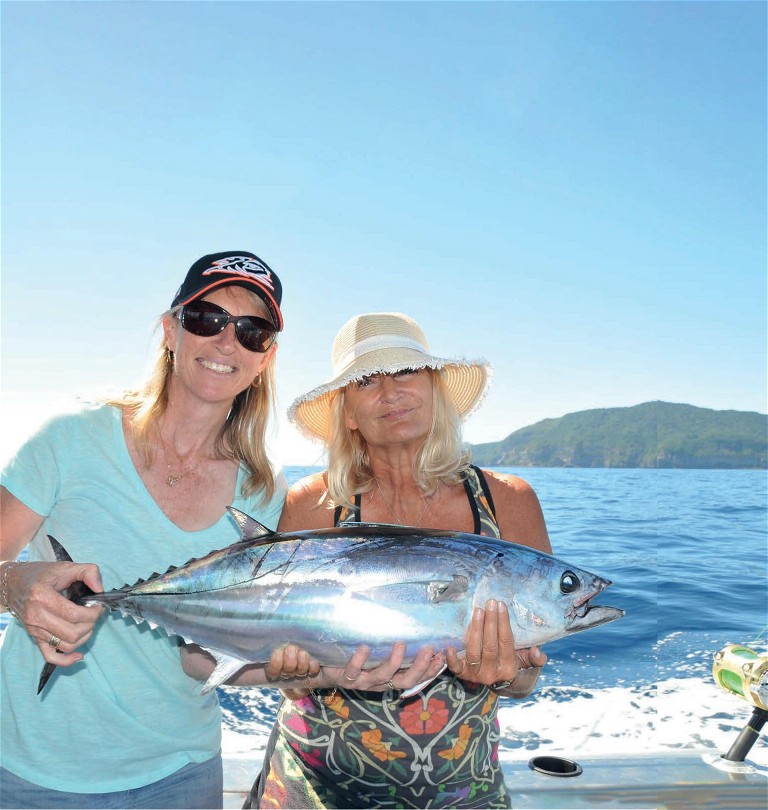
Skipjack approaching double figures are not common. This one jumped a marlin lure near Mayor Island.
Albacore
Although they are no slouches, albacore do not generate the same horsepower as skipjack. This is partly because they have a lot less red muscle. Albacore is well known as a ‘white meat tuna’ and is, to most European palates at least, a better table fish than skipjack. Their identifier is their greatly elongated pectoral fins, giving them the moniker ‘longfin tuna’ in some parts of the world.
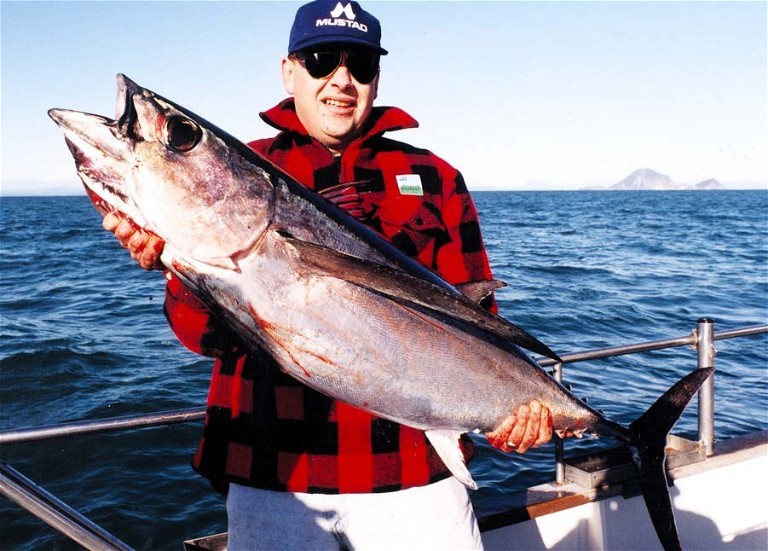
A big albacore taken jigging during the Bay of Plenty ‘winter run’.
They, too, are spread widely through the world’s oceans but seem to have a slower metabolic rate and greater temperature tolerance than their high-speed cousins. I have caught them in water temperatures ranging from 13-20°C in waters from Fiordland to the Three Kings Islands. They have apparently been caught in temperatures as low as 2°C!
Albacore captures vary from occasional tiny half-kilo specimens up to fish of around 25kg on rod and reel in local waters. The all-tackle world record is 40kg (again, Spain) and as a general observation, the cooler and deeper the water, the bigger the fish. We have caught some decent ones off Fiordland while trolling for bluefin in 16-degree water, and fish of over 20kg are caught in the Bay of Plenty in mid-winter, although this ‘run’ is a hit-andmiss affair. In the past, these fish were targeted at this time, but are now a welcome bycatch of boats chasing southern bluefin tuna in winter months.
Fishing for small tuna
There are a number of ways to target the small tuna species, but they have one thing in common – these speedsters can be easily targeted on light tackle as they are clean fighting. If the angler is patient and skilled, the tackle is good quality, and the rigging is up to standard, the only real risk of losing them is by having them taken by a shark or other predator.
Small tuna, like their larger cousins, have excellent eyesight, so rigging gear with light, neutrally coloured leaders will lift the strike rate in most circumstances. Heavy leaders may scrape by when they are partly hidden by the boat’s wake, visibility is poor, or the fish are in a feeding frenzy.
If using lures, ‘matching the hatch’ – using a lure close to the size and shape of what the tuna are feeding on – may also be important.
Speed is sometimes an important factor, too. These small tuna feed at speed, and troll or retrieve speeds of lures need to be fast to trigger a strike. The contradiction is that sometimes small tuna (particularly albacore) will take stationary or slowly sinking lures or baits.

The small tuna. These are more typical-sized albacore and skipjack from Hawkes Bay waters.
Trolling
For the average angler, trolling is the easiest system to use. A small (8-10cm) skirted lure rigged on a 24kg clear monofilament trace and trolled on any reasonable rig will do the job. My all-time favourites are either pink squid, ‘zucchini’, or ‘Xmas tree’ lures with weighted bullet heads. Many other colours and styles will work, including plastic squid, trolled flies and small minnow-type lures such as Halco Lazers and Rapalas.
Daisy chain rigs are very effective on small tuna. A fallback for shy tuna in calm conditions is the clear end snapped off a cheap ballpoint pen. The line is run through the middle and a smallish hook attached, the shank of which fits inside. This is a reasonable imitation of a larval baitfish.
This kind of fishing can be a whole lot of fun, as there is normally plenty of action to be had when you are in ‘the zone’. Sometimes we have a light tackle day, and troll a pattern of four little squids on three- and four-kilo baitcaster rigs. This is tremendous sport. A decent-sized skipjack or albacore on a three-kilo rig may need to be chased all over the ocean to avoid a water-drag popoff. Fights may last over half an hour.
Small tuna are particularly susceptible to lures towed on downriggers, even only 15 or 20 metres down. This is worth the effort if the tuna are shy. Another approach is to drop down further in lure size (use lightly dressed 4–5cm lures or flies) rigged on a six- or eight–kilo leader and fished well back behind the boat. ‘Fine and far out’ are the key words.
At other times you have to beat the small tuna off with a stick. When the numbers are good and they are biting well, a heavy bungie handline fished in the wake will harvest all the fish you need for the table or bait without any need to even stop the boat. This can be advantageous when trolling with larger gamefish as your primary aim.
Multiple hook-ups are a regular feature of small tuna trolling, and can be readily achieved on skipjack by running the boat on after the first strike. Albacore, by contrast, tend to school vertically rather than horizontally (as skipjack do). If the boat is stopped when an albacore hits, further strikes often come from members of the school as the other lures sink down to them. Another technique is to freespool unstruck lures after a fish is hooked, then retrieve them rapidly as the boat stops. This often results in further hook-ups. Albacore have large eyes and I have caught them on lures after dark, indicating they are quite capable of feeding at night and at considerable depths.
Light tackle spinning/jigging
It is always hard to say where spinning stops and jigging takes over. Both systems are pretty much the same except that jigging is carried out in a vertical rather than a horizontal plane. This is a technique to use when tuna are probably about, as indicated by meatballs, diving birds or bust-ups of the tuna themselves.
Small silver jig-type lures are the hot favourite for spinning, imitating the small baitfish the tuna often feed on. Tuna feed fast, so if casting to surface fish, give them plenty of lead and make fast, flat trajectory casts that get to the fish quickly. Retrieves also need to be at high speed. Consequently, small profile, but heavy lures with limited action are required. They cast well, imitate the baitfish, and can be retrieved at high speeds without bouncing out of the water. The Aussies call these lures ‘tuna slugs’ and home-made versions are cast in lead or knocked up by running a wire loop through the middle of a barrel sinker, before chrome or holographic tape is added. Some suitable commercially-made models are available here. Soft plastics work well, too.
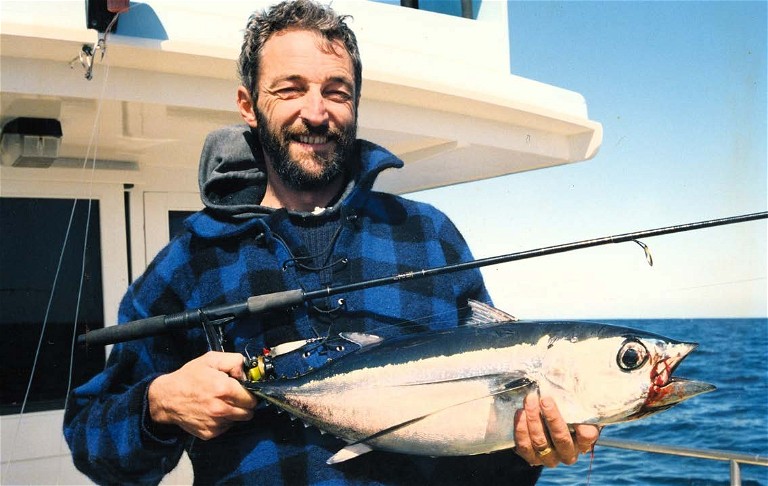
1) Light tackle, in this case a 3kg spin rig, can extract maximum performance from small tuna like this albacore.

2) Ten-centimetre chrome-headed pink squids are the writer’s favourite light-tackle troll lure for skipjack and albacore.
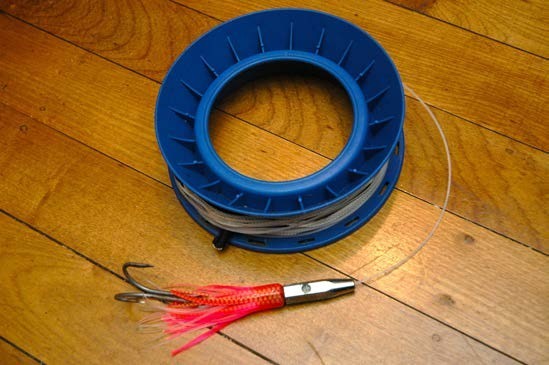
3) A bungie line and a pink hex-head lure. Good medicine for harvesting skipjack and albacore.
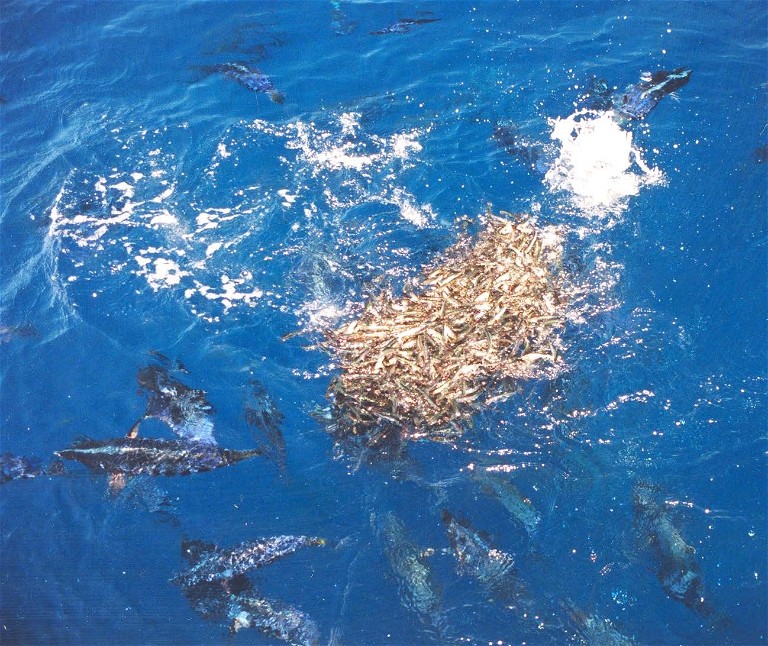
A school of skipjack in the process of annihilating a meatball of anchovies. A prime opportunity for light tackle spinning and flyfishing.
Tuna will also hit cast lures as they sink, especially if cast into the carnage of a meatball or workup. In this situation, use a more classic style jig with a little more flutter to it as it sinks. Albacore are more likely to be hooked on a deeply sunken jig, and do not usually need the very high-speed retrieves of skipjack (Alberts still like it fairly nippy, though.) I have regularly caught albacore on jigs fished in chum trails set for sharks, under birds, and along current break lines. I normally let the line sink to an angle of 45° before making a fast retrieve.
For spinning/jigging for tuna, a robust high-speed reel is required, either eggbeater or overhead. Depending on spool diameter, gear ratio needs to be 5:1 or 6:1. Good winding coordination is a big advantage for the angler.
Other ways to target albacore and skipjack include saltwater fly, small livebaits and drifting small cut baits down a chum trail, but we are running out of space here, so the special tackle and tactics used will have to wait for another article.

“ TUNA WILL ALSO HIT CAST LURES AS THEY SINK, ESPECIALLY IF CAST INTO THE CARNAGE OF A MEATBALL OR WORKUP. ”
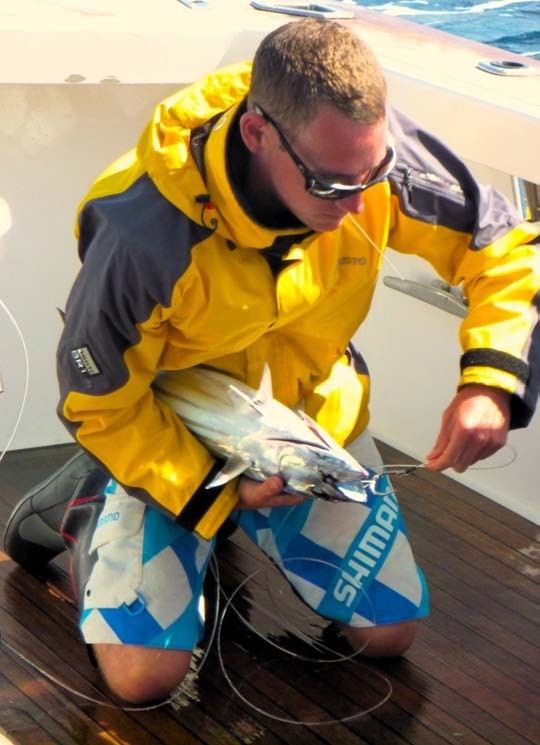

At the end of the day
Skipjack and albacore are true sport fish, but valuable to anglers in other ways. Skipjack provide some of the best cut baits going and are also great livebaits or pitch baits for marlin. If not used fresh, I store them up in my bait freezer until I have sufficient to process. The fillets are cut into bait-sized pieces, salted to toughen them, then stored in the freezer. The frames and heads go through a mincer and are converted into berley bombs. Albacore are great eating fish. On capture they are bled by cutting the large arteries just behind the pectoral fins, then chilled down. Cooked fresh (baking or grilling is best), they will provide a memorable meal, I promise you.
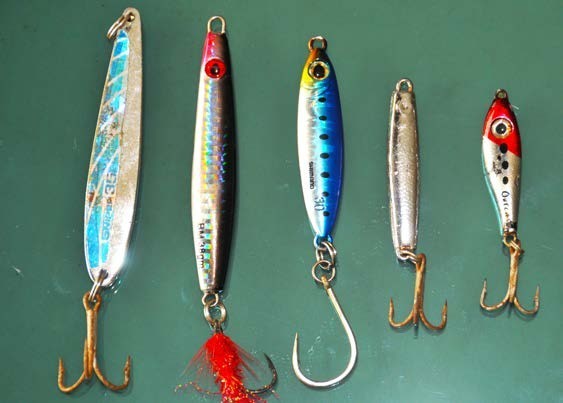
1) Successful casting lures. Right are three tuna slugs designed for distance casting and quick retrieves. The others have a little more flutter and may be hit as they sink under a bait school.

2) Fishing up the food chain. The skipjack was taken on a cast soft-plastic lure and provided a cut bait which produced the snapper.
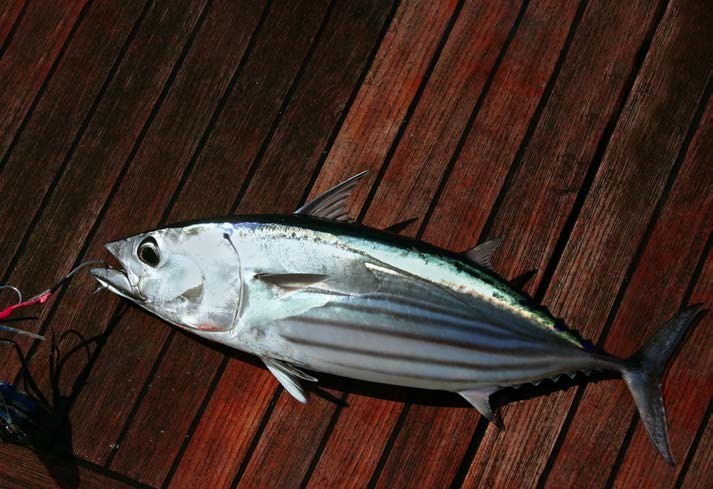
“ SKIPJACK ARE PHENOMENAL BREEDERS. AN AVERAGE FEMALE SKIPJACK CAN PRODUCE AROUND A MILLION EGGS A DAY… ”